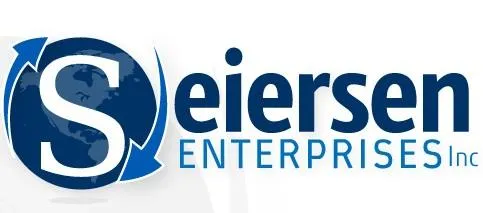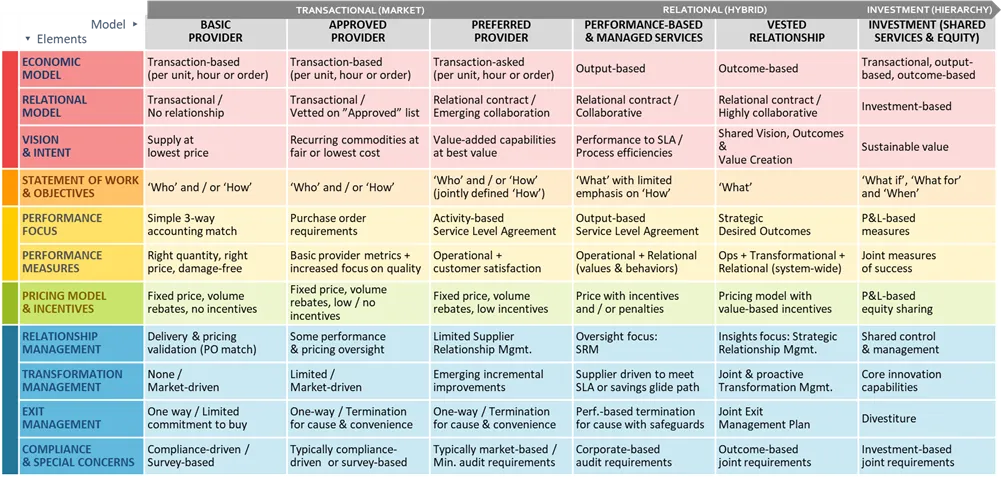
Welcome to Seiersen Enterprises
E
Enjoy our blogs here
Sustainable Supply Chain Value Through the Right Deals with the Right Trading Partners
Digitizing the Supply Chain
Check out my blogs on Linkedin: https://www.linkedin.com/in/nicholasseiersen/recent-activity/articles/
Trust & Trading Relationships

7 Sourcing Models
Last time we looked at how to select the right business model for each deal. This table shows the different elements of each deal. It is important that all of the elements be aligned for each model to be effective.
The use of the 7 Sourcing Models drives a constructive dialogue with the business about how they want to work with the suppliers and what value proposition they want. The most collaborative of these sourcing models is Vested, where exceptional value is sought by working with the most qualified providers. Supply Chain Mapping is used to visualize the entire supply chain, including suppliers’ suppliers, to highlight risks through geographic or sub-supplier concentration. Combined with a Supply Chain Control Tower, the visibility into inbound and outbound shipments and their progress against plan provides an exceptional early warning capability for service failure recoveries.
Most relationships are transactional both on the economic and relational dimension. Service level assurances and inventory or time buffers may suffice to weather most disruptions, and contingency planning table-top exercises can improve readiness for the next “Black Swan.”
But what about the handful of strategically critical relationships that deliver outsize results in services that are critical to the business? We use the 5 Vested rules
Outcome based – what do you really want to achieve - rent a drill to make a hole, or hang a picture?
What not how – when you engage with experts that do what you want done all day/every day and have developed carefully honed skills, capabilities and tools, don’t try to tell them how to do their job. Tell them what makes it special and difficult for you and let them work out how to do it in the best way possible.
Defined and measured outcomes – outcomes are important, but how you recognize the success is really critical to making it real.
Pricing Model with incentives – obtaining outstanding results from something you don’t want to do yourself is fraught with risks. For the risks that are core to the delivery and success, a pricing model allows you to pay for performance.
Insight vs oversight - focus on fixing challenges, not assigning blame.
A What’s in it for WE mindset drives solidarity and loyalty to the relationship and equity in all dealings. A What’s in it for ME approach can drive unproductive and exploitative behaviors that do not serve the ultimate goals.
Many of you would typically live by these rules naturally with your friends or colleagues. Why not with your suppliers on whom you really do depend?
Data Quality

7 Sourcing Models
Last time we looked at how to select the right business model for each deal. This table shows the different elements of each deal. It is important that all of the elements be aligned for each model to be effective.
The use of the 7 Sourcing Models drives a constructive dialogue with the business about how they want to work with the suppliers and what value proposition they want. The most collaborative of these sourcing models is Vested, where exceptional value is sought by working with the most qualified providers. Supply Chain Mapping is used to visualize the entire supply chain, including suppliers’ suppliers, to highlight risks through geographic or sub-supplier concentration. Combined with a Supply Chain Control Tower, the visibility into inbound and outbound shipments and their progress against plan provides an exceptional early warning capability for service failure recoveries.
Most relationships are transactional both on the economic and relational dimension. Service level assurances and inventory or time buffers may suffice to weather most disruptions, and contingency planning table-top exercises can improve readiness for the next “Black Swan.”
But what about the handful of strategically critical relationships that deliver outsize results in services that are critical to the business? We use the 5 Vested rules
Outcome based – what do you really want to achieve - rent a drill to make a hole, or hang a picture?
What not how – when you engage with experts that do what you want done all day/every day and have developed carefully honed skills, capabilities and tools, don’t try to tell them how to do their job. Tell them what makes it special and difficult for you and let them work out how to do it in the best way possible.
Defined and measured outcomes – outcomes are important, but how you recognize the success is really critical to making it real.
Pricing Model with incentives – obtaining outstanding results from something you don’t want to do yourself is fraught with risks. For the risks that are core to the delivery and success, a pricing model allows you to pay for performance.
Insight vs oversight - focus on fixing challenges, not assigning blame.
A What’s in it for WE mindset drives solidarity and loyalty to the relationship and equity in all dealings. A What’s in it for ME approach can drive unproductive and exploitative behaviors that do not serve the ultimate goals.
Many of you would typically live by these rules naturally with your friends or colleagues. Why not with your suppliers on whom you really do depend?
Other Supply Chain Topics

7 Sourcing Models
Last time we looked at how to select the right business model for each deal. This table shows the different elements of each deal. It is important that all of the elements be aligned for each model to be effective.
The use of the 7 Sourcing Models drives a constructive dialogue with the business about how they want to work with the suppliers and what value proposition they want. The most collaborative of these sourcing models is Vested, where exceptional value is sought by working with the most qualified providers. Supply Chain Mapping is used to visualize the entire supply chain, including suppliers’ suppliers, to highlight risks through geographic or sub-supplier concentration. Combined with a Supply Chain Control Tower, the visibility into inbound and outbound shipments and their progress against plan provides an exceptional early warning capability for service failure recoveries.
Most relationships are transactional both on the economic and relational dimension. Service level assurances and inventory or time buffers may suffice to weather most disruptions, and contingency planning table-top exercises can improve readiness for the next “Black Swan.”
But what about the handful of strategically critical relationships that deliver outsize results in services that are critical to the business? We use the 5 Vested rules
Outcome based – what do you really want to achieve - rent a drill to make a hole, or hang a picture?
What not how – when you engage with experts that do what you want done all day/every day and have developed carefully honed skills, capabilities and tools, don’t try to tell them how to do their job. Tell them what makes it special and difficult for you and let them work out how to do it in the best way possible.
Defined and measured outcomes – outcomes are important, but how you recognize the success is really critical to making it real.
Pricing Model with incentives – obtaining outstanding results from something you don’t want to do yourself is fraught with risks. For the risks that are core to the delivery and success, a pricing model allows you to pay for performance.
Insight vs oversight - focus on fixing challenges, not assigning blame.
A What’s in it for WE mindset drives solidarity and loyalty to the relationship and equity in all dealings. A What’s in it for ME approach can drive unproductive and exploitative behaviors that do not serve the ultimate goals.
Many of you would typically live by these rules naturally with your friends or colleagues. Why not with your suppliers on whom you really do depend?
Office: Sidney, BC
Canada
Call 647-299-8360
Email:nick@seierseninc.com
Site: www.seierseninc.com

